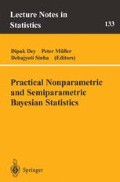Abstract
The quantification of prior information is a very important problem in a Bayesian analysis. In many situations, especially in clinical trials, the investigator has historical data from past studies which are similar to the current study. In this chapter, we discuss a class of informative prior distributions for Cox’s proportional hazards model. A novel construction of the prior is developed for this semiparametric model based on the notion of the availability of historical data. The prior specifications focus on the observables in that the elicitation is based on a prior prediction yo for the response vector and a quantity ao quantifying the uncertainty in yo. Then, yo and ao are used to specify a prior for the regression coefficients in a semi-automatic fashion. One of the main applications of our proposed priors is for model selection. Efficient computational methods are proposed for sampling from the posterior distribution and computing posterior model probabilities. A real data set is used to demonstrate our methodology.
Access this chapter
Tax calculation will be finalised at checkout
Purchases are for personal use only
Preview
Unable to display preview. Download preview PDF.
References
Arjas, E., and Gasbarra, D. (1994), “Nonparametric Bayesian inference from right censored survival data, using the Gibbs sampler”. Statistica Sinica,4, 505–524.
Bedrick, E. J., Christensen, R., and Johnson, W. (1996), “A New Perspective on Priors for Generalized Linear Models.” Journal of the American Statistical Association, 91, 1450–1460.
Chen, M.-H. (1994), “Importance-weighted Marginal Bayesian Posterior Density Estimation.” Journal of the American Statistical Association, 89, 818–824.
Chen, M. -H., Ibrahim, J. G., and Yiannoutsos, C. (1998), “Prior Elicitation, Variable Selection, and Bayesian Computation for Logistic Regression Model,” Journal of the Royal Statistical Society, Series B, to appear.
Chen, M.-H. and Shao, Q.-M. (1997a), “Estimating Ratios of Normalizing Constants for Densities with Different Dimensions,” Statistica Sinica, 7, 607–630.
Chen, M.-H., and Shao, Q.-M. (1997b), “On Monte Carlo Methods for Estimating Ratios of Normalizing Constants,” The Annals of Statistics, 25, 1563–1594.
Cox, D. R. (1972). Regression models and life tables, (with discussion). J. R. Statist. Soc. B 34, 187–220.
Cox, D. R. (1975). Partial likelihood. Biometrika 62, 269–276.
Gilks, W.R., and Wild, P. (1992), “Adaptive Rejection Sampling for Gibbs Sampling,” Applied Statistics, 41, 337–348.
Ibrahim, J. G., and Chen, M.-H. (1997), “Prior Distributions and Bayesian Computation for Proportional Hazards Models,” submitted.
Ibrahim, J. G., Chen, M.-H., and MacEachern, S. N. (1996), “Bayesian Variable Selection for Proportional Hazards Model,” submitted.
Kalish, L. A. (1992), “Phase III Multiple Myeloma: Evaluation of Combination Chemotherapy in Previously Untreated Patients,” Technical Report # 726E, Department of Biostatistics, Dana-Farber Cancer Institute.
Krall, J. M., Uthoff, V. A., and Harley, J. B. (1975), “A Step-up Procedure for Selecting Variables Associated with Survival,” Biometrics, 31, 4957.
Laud, P. W., and Ibrahim, J. G. (1995), “Predictive model selection,” Journal of the Royal Statistical Society, Series B, 57, 247–262.
O’Neill, R. (1971), “Algorithm AS47-Function Minimization Using a Simplex Procedure,” Applied Statistics,20, 338–345.
Sinha, D. and Dey, D. K. (1997), “Semiparametric Bayesian Analysis of Survival Data,” Journal of the American Statistical Association, 92, 1195–1212.
Sinha, D., Chen, M-H., and Ghosh, S. K. (1997), “Bayesian analysis and model selection for interval-censored survival data”. Submitted for publication.
Sinha, D. (1998), “Time-discrete beta process model for interval censored survival data”. Canadian Journal of Statist.,27,to appear.
Tsiatis, A. A. (1981). A large sample study of Cox’s regression model. Ann. Statist. 9, 93–108.
Editor information
Editors and Affiliations
Rights and permissions
Copyright information
© 1998 Springer Science+Business Media New York
About this chapter
Cite this chapter
Ibrahim, J.G., Sinha, D. (1998). Prior Elicitation for Semiparametric Bayesian Survival Analysis. In: Dey, D., Müller, P., Sinha, D. (eds) Practical Nonparametric and Semiparametric Bayesian Statistics. Lecture Notes in Statistics, vol 133. Springer, New York, NY. https://doi.org/10.1007/978-1-4612-1732-9_15
Download citation
DOI: https://doi.org/10.1007/978-1-4612-1732-9_15
Publisher Name: Springer, New York, NY
Print ISBN: 978-0-387-98517-6
Online ISBN: 978-1-4612-1732-9
eBook Packages: Springer Book Archive

